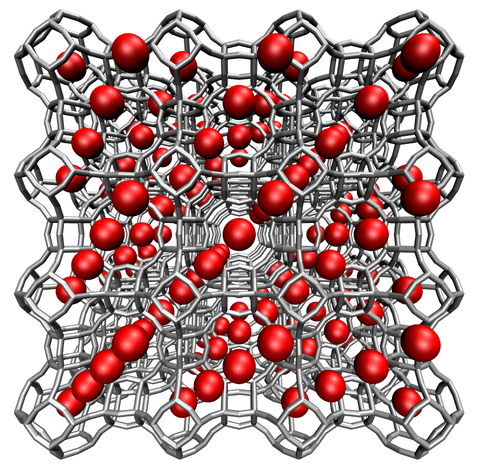Industrial Gas Separation and Purification

A conceptual illustration of a porous crystalline material. The red spheres represent voids where CO2 might collect.
Gas separation technology has widespread applications across a broad array of industrial sectors, including energy generation, chemical manufacturing, semiconductors, and aerospace. Examples include the removal of impurities (e.g., CO2 and H2S) from methane in natural gas processing and the separation of light hydrocarbons (ethane/ethylene) for petrochemical feedstocks. An emerging class of materials that has shown significant promise in these applications are metal-organic frameworks (MOFs) and covalent organic frameworks (COFs). These materials have important properties, including high surface area, pore size tunability, and chemical selectivity in adsorption that make them attractive for gas separation applications. The development of methodologies for material identification and selection, along with those for characterization of structure-property-performance relationships, is key to optimizing the development of these materials for specific applications. This methodology development is the central area of effort for MMSD researchers in the Gas Separation and Purification focus area.
Capabilities
Research in the MMSD Gas Separation and Purification focus area benefits significantly from access to world-class synchrotron X-ray beamlines at the Advanced Photon Source and NSLS-II, enabling single crystal X-ray diffraction measurements of sorbents and sequestration materials and in-situ / operando characterization of adsorption processes. Collaborative measurements at the NIST Center for Neutron Research (NCNR) also allow neutron diffraction characterization of sorbent materials. MMSD expertise in autonomous experimentation and machine learning (ML) algorithm development is being applied in the development of an autonomous sorbent materials foundry. Computational capabilities are also essential to the focus area, including the use of density functional theory (DFT) in modeling porosity and gas adsorption.
Metrology For Advanced Materials Characterization for Gas Separation And Purification
The technical needs for identifying and optimizing the materials necessary to address the challenges relevant to gas separation range broadly across synthesis, structural and chemical characterization, and metrology for process performance and long-term durability. MMSD researchers are actively addressing problems in each of these key areas.
- Structure-property-performance relationships in porous materials for gas separation applications — The development of structure-property-performance relationships for porous sorbents is essential for the discovery and optimization of the most effective materials. Utilizing world-class X-ray and neutron metrology facilities, MMSD researchers employ a combination of single crystal, X-ray diffraction structure determination, density functional theory-based calculations of pore structure, and simulations of gas adsorption, coupled with in situ X-ray scattering measurements of structural changes under model operating conditions to study structure-property relationships in flexible MOF sorbent materials. Considerable effort has been directed to the study of pillared cyano nickelate MOFs, a promising material for gas separation applications in which the pore size, chemistry, and structural dynamics can be varied through choices of ligands and pore functionality. MMSD researchers have also recently initiated the establishment of a synthesis laboratory with a pilot project on metal-organic framework (MOF) compounds to facilitate access to advanced materials necessary for metrology development. This work is being done in concert with the development of active collaborations with world-leading MOF synthetic laboratories.
- AI for Gas Separation and Purification: Guiding Discovery of Sorbent Materials — The operating conditions for specific gas separation applications impose strict performance requirements on candidate sorbent materials. MMSD has developed a machine learning (ML) algorithm to guide experimentalists to likely high-performing candidate materials from their atomistic structure. The NIST Adsorption Database has been expanded to include more theoretical calculations of adsorption isotherms and to facilitate computational correlation of adsorption isotherms with material properties. Additionally, efforts are focused on the development of robust performance metrics for sorbent materials in specific applications. Work is also ongoing on the development of an autonomous, high throughput materials characterization system to study the synthesis of porous materials for gas separation applications. The aim of this platform development is to generate much-needed standardized datasets on porous material synthesis and the dissemination of the platform design and associated ML algorithms to further accelerate research on the development of advanced materials for these applications.
- Nanocalorimetry for Sorbent Characterization — Nanocalorimetry is a measurement technique able to explore the thermal behavior of materials at faster rates on smaller length scales than traditional bulk thermal techniques during processes such as adsorption/desorption. MMSD is exploring the use of nanocalorimetry to characterize the adsorption/desorption process in candidate sorption materials. Nanocalorimetry can measure the thermal signatures of the adsorption and desorption events and help select suitable activation procedures. Additionally, nanocalorimetry is being used to significantly accelerate thermal cycle stability evaluation during the adsorption-desorption process, a sorbent material characteristic that is critical to field performance and viability but challenging to measure via traditional methods.

